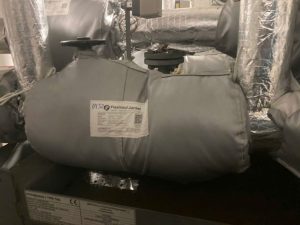Choosing the right type of heat-resistant sewing thread is a critical factor that directly determines the durability and effectiveness of insulation products like removable insulation jackets and blankets. A poor-quality seam can compromise an entire expensive product. This article will analyze common materials in detail and provide key criteria to help you select the optimal solution.
The Importance of Heat-Resistant Thread in Insulation Jackets
In harsh industrial environments, insulation jackets help maintain stable temperatures, save energy, and ensure operational safety. However, their performance depends not only on the insulation fabric but also on an often-overlooked detail: the sewing thread.
Using the wrong type of thread can lead to serious consequences:
- Seam Failure: Standard thread will quickly degrade and break when exposed to high temperatures, causing the insulation jacket to come apart or tear.
- Chemical Damage: In environments with corrosive chemicals, unsuitable thread will be destroyed, reducing the product’s lifespan.
- Increased Costs: Repairing and replacing prematurely failed insulation jackets is costly and can disrupt production operations.
Therefore, investing in specialized heat-resistant sewing thread from the start is a smart decision to ensure long-term safety and efficiency.
Differentiating Common Heat-Resistant Thread Materials
Understanding the properties of each material is the first step toward making the right choice.
Aramid Thread (Common brands: Kevlar®, Nomex®)
Aramid is a high-performance synthetic fiber renowned for its mechanical strength and superior heat and flame resistance.
- Key Properties:
- Excellent tensile strength: Extremely resistant to cuts and abrasion.
- High-temperature resistance: Does not melt; only carbonizes at very high temperatures.
- Organic solvent resistance: Durable in many industrial environments.
- Ideal applications: Insulation jackets requiring high mechanical strength, resistance to impact, and friction in industries such as metallurgy, oil and gas, defense, and automotive manufacturing.
Polytetrafluoroethylene (PTFE) Thread (Common brand: Teflon™)
PTFE is a unique polymer known for its near-universal chemical resistance and extremely low coefficient of friction.
- Key Properties:
- Excellent chemical resistance: Inert to most acids, bases, and strong corrosive agents.
- UV and weather resistance: Very durable for outdoor use, unaffected by sunlight or moisture.
- Non-stick surface: Resists build-up and is easy to clean.
- Ideal applications: Chemical plant environments, wastewater treatment systems, pharmaceutical manufacturing, and outdoor insulation equipment.
Fiberglass Thread
Made from extremely fine glass filaments, this is an inorganic material with excellent fire resistance and insulation properties at very high temperatures.
- Key Properties:
- Extreme high-temperature resistance: Does not burn and maintains stability at temperatures that other synthetic fibers cannot withstand.
- Good tensile strength and does not shrink from heat.
- Competitive price: Often costs less than Aramid and PTFE.
- Limitations: Less flexible and has lower abrasion resistance than synthetic fibers; can break if repeatedly bent or subjected to constant friction.
- Ideal applications: Static applications with minimal mechanical stress that require extreme fire resistance and high-temperature capability.
4 Key Criteria for Selecting Heat-Resistant Sewing Thread
To ensure you make the right choice, answer the following four questions:
1. What is the operating temperature?
Determine the continuous operating temperature and the maximum temperature the seam will be exposed to. Each material has a different temperature threshold; choosing a thread with a lower limit than required will lead to failure.
2. Are corrosive chemicals present in the environment?
If the product will be exposed to acids, bases, or solvents, PTFE thread is the safest and most durable option due to its superior chemical resistance.
3. What are the mechanical strength requirements?
Evaluate the level of abrasion, tension, and other physical stresses on the seam. For applications that require cut and tear resistance, Aramid thread is the optimal solution.
4. Will the product be installed outdoors?
For outdoor insulation jackets, UV and weather resistance are mandatory to prevent material degradation. PTFE thread is the leading choice for these applications.
Selecting the right sewing thread is not just a technical detail but an investment in the safety and efficiency of your entire system. If you need more in-depth advice, do not hesitate to contact experts to find the most suitable solution for your project.
Request consultation and quotation now!Frequently Asked Questions
Which is the highest temperature-resistant sewing thread?
Threads made from fiberglass or ceramic fibers have the highest temperature resistance. However, Aramid and PTFE threads are more common due to their excellent balance of heat resistance, mechanical strength, and chemical resistance.
What is the main difference between Aramid (Kevlar) and PTFE thread?
Aramid (Kevlar) excels in mechanical strength, cut resistance, and abrasion resistance. In contrast, PTFE stands out for its near-total chemical inertness and UV resistance, making it ideal for outdoor applications.
Why is special thread required for insulation jackets?
Because standard sewing thread will quickly degrade and break when exposed to high temperatures or chemicals, compromising the entire structure of the insulation jacket, leading to energy loss and safety hazards.
Is heat-resistant sewing thread also chemical-resistant?
Yes, especially PTFE thread. This material is almost completely inert to most acids, bases, and corrosive solvents, making it a top choice for the chemical industry.










